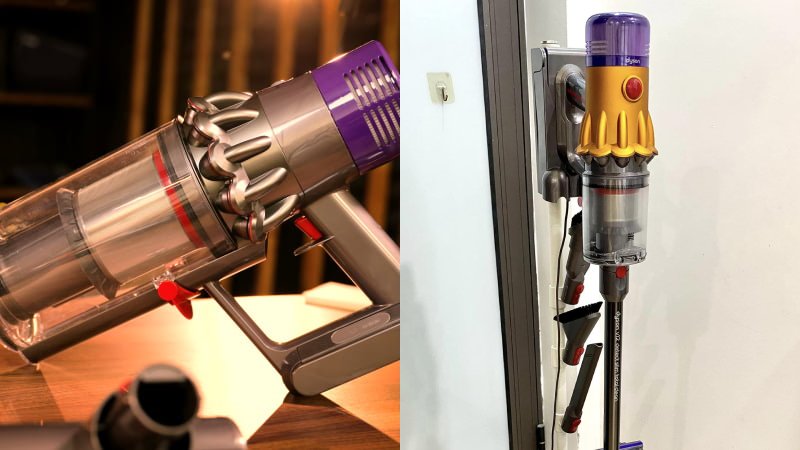Dyson V10 vs V12: both are highly competent vacuum cleaners, however, they differ in terms of price, features, and other identifying characteristics. If I had to choose the best, I would go with the Dyson V12.
The Dyson V12 has a much more advanced power adjustment feature. When used on the carpet or in an area with a lot of debris, it can automatically increase its suction setting. It also works a little better on bare floors and is more lightweight, making it easier to maneuver. With an LCD screen and a Piezo sensor, I find that using it is more convenient.
That said, the Dyson V10, which comes in second place, performs a better job on low-pile carpets and has a larger dirt compartment that does not need to be emptied as frequently as the winner. It is also a more affordable vacuum, yet it still has roughly the same cleaning performance as the V12.
Dyson V10 vs V12: Comparison Chart




Dyson V10 vs V12: Differences
The Dyson V12 beats the V10 by a score of 2-1 and ties once. Both have fantastic cleaning performance, but you will find the Dyson V12 has more conveniences and utilities. Meanwhile, the Dyson V10 has a bigger dirt compartment.
Cleaning Performance
The Winner: Tie
Motor Power
Both the V10 and the V12 are equipped with rotational motors that can reach speeds of up to 125,000 revolutions per minute (RPM). This is an impressive number!
The Dyson V12 comes with a Dyson Hyperdymium motor, whilst the Dyson V10 comes equipped with a digital motor; yet, their performance is comparable.
Floor Cleaning Performance
Let’s start with cleaning performance, one of the most important factors to think about while looking for a new vacuum. In my tests, I found that both the V10 and the V12 performed admirably; nevertheless, the devil is in the details.
I put them through a series of tests to see how well they cleaned four distinct types of debris, each of which represents a different size of debris, on three distinct kinds of flooring (hard floor, low-pile carpet, and high-pile carpet).
- Dyson V10
The Dyson V10 performed admirably on all floor types, effectively picking up nearly all dust and dirt. It has a sufficient suction force to clear up granulated sugar, cereals, rice, and even kitty litter:
During our tests, the V10 had a tendency to become clogged if I attempted to quickly vacuum large amounts of cereal with the fluffy cleaning head. Despite this, it was successful in clearing away all of the debris.
Also, despite the fact that both models had the same amount of suction power, I discovered that the Dyson V10 performed somewhat better than the V12.
- Dyson V12
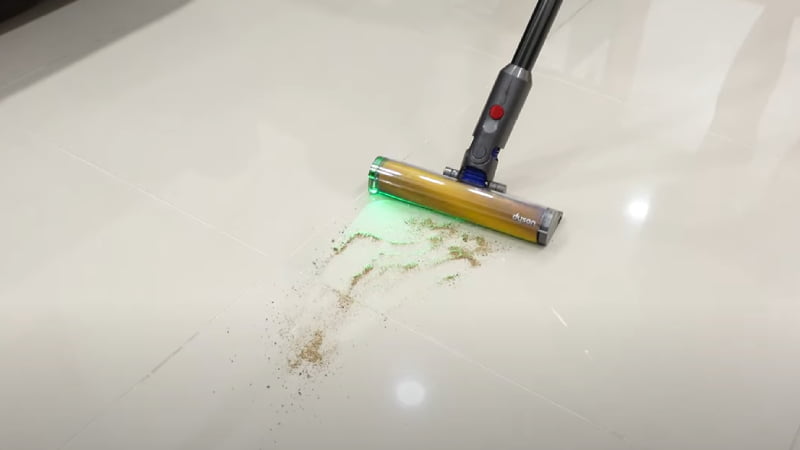
Just like the Dyson V10, the V12 has 150 AW of suction power. As a result, it performed similarly on the majority of different types of flooring, with the exception of high-pile carpets, on which the V12 struggled a little.
I ran into a few problems when removing fine and small debris like sugar from low- and high-pile carpets, but except from that, its performance was up to par.
Cleaning Modes
The Dyson V10 may be switched between three different power settings to adjust its suction:
- Suction 1: in this setting, the vacuum has the longest run time.
- Suction 2: suited to clean bare floors and carpets.
- BOOST mode: suited for clearing away stubborn dirt and debris.
In addition to that, there is an indicator for the blockage as well as a filter light. It is not able to automatically change power when it detects large quantities of debris on the ground or when it is being used on the carpet.
If you use the Dyson V12, there is a little silver button located just underneath the screen that allows you to choose between the three possible power modes. These modes include the energy-efficient ‘Eco’ mode, the high-suction ‘Boost’ mode, and the ‘Auto’ mode, which automatically boosts suction when you’re cleaning carpet or moving the vacuum over areas with a lot of dirt and debris.
Dynamic Load Sensor
The “Dynamic Load Sensor” on the Dyson V12 contains a sensor that can automatically adjust the power depending on the type of floor being cleaned. Without having to switch attachments, I can give both carpeted and hard floors a thorough cleaning while maintaining the appropriate amount of suction.
The Dyson V10 does not come equipped with the Dynamic Load Sensor (DLS) technology like the Dyson V12. But, the torque drive head of the Dyson V10 does have a suction control slider, and you still have the option to pick between three different suction power settings, so you can complete any task on any kind of flooring. But you have to crouch down to adjust the slider.
Dustbin Capacity
The Winner: Dyson V10
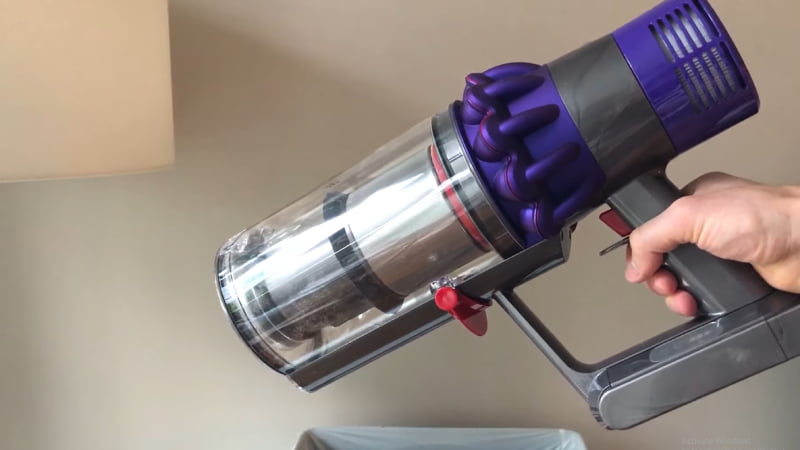
The capacity of the dustbin is another significant distinction between these two different Dyson machines. The dust container on the V10 is twice as large as the one on the V12 model. Their dustbin’s capacity is 0.2 gallons (0.75 L) and 0.1 gallons (0.38 L), respectively. The Dyson V10 has a larger capacity, thus it needs to be emptied less frequently.
Design & Convenience
The Winner: Dyson V12
Weight & Maneuverability
Both the V10 and the V12 are straightforward to use. Although the Dyson V12 is more compact and less in weight, the difference is basically negligible (5.2 lbs vs. 5.7 lbs). In addition, both models may be utilized as handheld devices, which makes it much easier to transport them from place to place.
Consider the capacity of the dustbin, too. As was indicated before, the Dyson V10 has a substantially larger capacity for holding debris than the V12 does; nevertheless, it is also somewhat bulkier. Because of these factors, I believe that it is most suited for cleaning larger houses as opposed to smaller apartments or studios.
Run Time Performance
You can run both the Dyson V10 and V12 constantly for up to 60 minutes on a single charge. However, the actual run time varies depending on the power mode and the cleaning heads that are attached.
The V12 requires a longer charging time than the V10 by around 4 hours. Whereas the V10 takes 3.5 hours. The click-in battery in the V12 can be quickly and easily removed. So, in case you require an additional run time, you can purchase a spare one.
The Dyson V10 also features a detachable battery, but removing and replacing it is more of a hassle. The battery, on the other hand, should last for up to 15 years, which is equivalent to 800 charge cycles and is rather remarkable.
On/Off Control
When using the V10, you are required to keep your finger on the trigger all the time. This function may appear to be bothersome, but it actually helps you save battery energy and achieve longer run times. The instant you remove your hand from the trigger, the vacuum will immediately stop functioning. That irritated me to no end. Because I have to keep pressing that down the entire time, my wrists start to hurt after a while.
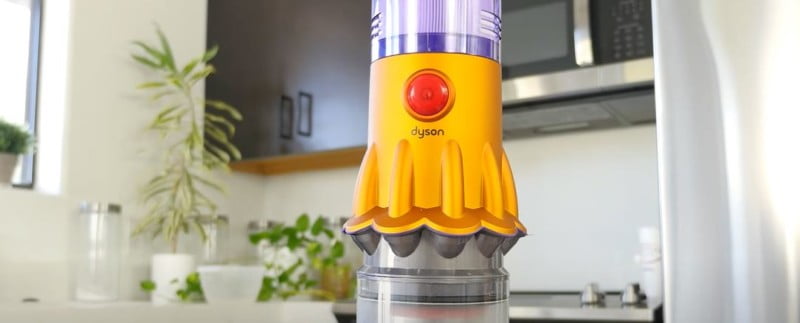
Unlike the Dyson V10, I found the V12 to be far less irritating. It is equipped with a regular on/off button that is situated above the trash can. Because of this, it is virtually hard to turn on the device by accident, which is something that might happen with the V10. It’s easier on the fingers, so you can clean for longer without becoming tired.
Charge Time
As mentioned earlier, the Dyson V12 takes 30 minutes longer to charge compared to the Dyson V10. However, it shouldn’t be an issue. If you are pressed for time, you can complete the task by making use of a spare battery.
Utilities
The Winner: Dyson V12
Digital Display
The Dyson V12 has an LCD screen where you can see how much battery life is left and access or modify the following factor:
- Suction power
- Cleaning mode
- Particle size and type
- Maintenance reminders
This is an interesting gimmick, but other than the fact that you can see the rate of collection slowing down as your carpet gets cleaner, I can’t imagine anyone finding it as useful as it has been advertised.
The Dyson V10 doesn’t offer this LCD screen, but it has a battery life indicator that shows how much time is left on the battery.
Piezo Sensor
The fact that the V12 makes use of piezo sensors to determine the size, type, and quantity of particles is one of the features that I appreciate the most about it. This information will be displayed on the digital display, and it will allow the vacuum to make automatic adjustments to the amount of power and suction as needed.
The Dyson V12 and V15 are the only available cordless vacuums featuring Piezo sensors at this time. The V10 is lacking this feature, but considering its more reasonable price tag.
Click-in Battery
The battery release process is where the V10 and V12 diverge significantly.
The battery of the Dyson V12 is a click-in type, making removal and replacement a quick and easy process. For example, you can take it out when it’s completely discharged and put in a spare one to make it run longer.
The battery in the V10 can also be removed, although doing so requires the use of a special tool (a screwdriver) to take it out. As a result, only when it stops holding a charge should you take it out (and replace it with a new one).
Green Laser
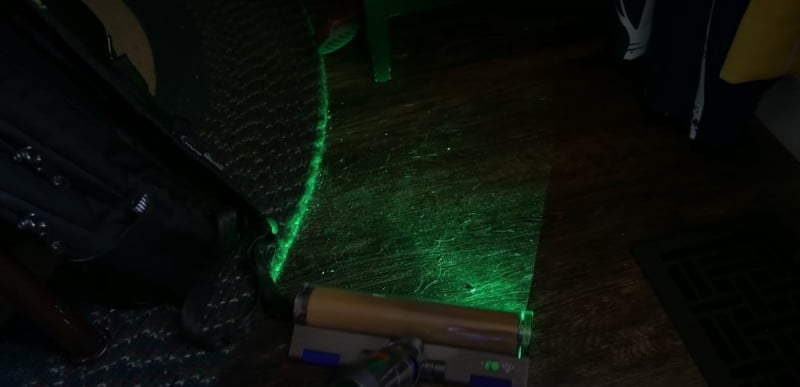
There is one flagship feature that the V12 comes equipped with that truly differentiates it from the Dyson V10 model. It is the green laser. When you use the main Laser Slim Fluffy cleaner head, a green laser will highlight the floor in front of you, revealing any hairs, crumbs, dust, or spills that are on the floor (you can also switch it off).
Quick Rundown of Dyson V12
Quick Rundown of Dyson V10
- Up to 60 minutes run time when using a non-motorized tool. Cyclone technology: 14 concentric cyclones. Filtration: advanced whole machine filtration. Cleaning path width - 9.84 inches
- Dyson technology helps create a cleaner, healthier home - Our vacuums and purifiers are scientifically proven to capture particles as small as allergens and bacteria.
- Lightweight and versatile, to clean right through the home. Instant-release trigger means battery power is only used while it’s cleaning. Requires charging for 3.5 hours minimum before first use
- Up to 40 minutes of fade-free power with the soft Roller cleaner head (in suction mode I). engineered to pick up both large debris and Fine dust
- Torque drive cleaner head – Up to 20 minutes of fade-free power (in suction mode II). drives stiff nylon bristles into carpets to capture deep-down dirt
Product Videos
Related Articles to Dyson V12
- Karcher Vc7 vs Dyson V12: The Vacuum Faceoff You Didn’t Know You Need!
- Dyson V12 Vs Samsung Jet 60: Very Lightweight But What Are Their Good & Bad?
- Dyson V8 vs V12: Which Option Is Better?
- Dyson V12 vs V11: Ultimate Side-by-side Comparison
- LG CordZero Vs Dyson V12: A Handstick Vacuum Comparison
- Samsung Jet 70 Pet Vs Dyson V12 Slim: Both Are Lightweight & Compact But Which Is Better?
- Dyson V12 vs Philips 8000: Choose Your Ultimate Power-Infused Vacuum!
- Roborock H7 vs Dyson V12: A Newest Head-To-Head Comparison
- Tineco S11 Vs Dyson V12: Review Of The Two Most Excellent New Generation Vacuum Cleaners
- Dyson Ball Animal 3 vs V12: Let’s Looking For The Top-Of-The-Line Dyson Vacuum
- Tineco S12 Vs Dyson V12: A Detailed Cordless Vacuum Guide
- Dyson V12 Extra vs Absolute: There Is Only One Difference, And That Is…
- Samsung Jet 75 Vs Dyson V12: A Showdown Of The Best Stick Vacuums
- Samsung Bespoke Jet Vs Dyson V12: What Are Differences Between Two Advanced Stick Vacuums?
- Samsung Jet 90 Vs Dyson V12: A Head-To-Head Comparison
Related Articles to Dyson V10
- Dyson V11 Torque Drive Vs V10 Animal: An Honest Cleaning Power Comparison
- Tineco PURE ONE S11 vs Dyson V10: Which Reigns Supreme For Powerful Cleaning?
- Dyson V10 Absolute Vs Shark Ion F80: Honest Comparison – Which Is The Better?
- Tineco A11 vs Dyson V10: Battle Of The Powerful Vacuum Cleaners
- Dyson V10 Vs Xiaomi V11: Unraveling The Best Cordless Vacuum Choice
- Dyson V10 vs V11: Which Should You Buy?
- Dyson Cyclone V10 Animal vs Dyson Ball Animal 2: Which Vacuum Should You Get? – Cordless vs Corded!
References:
- Dyson V10: https://www.dyson.com/vacuum-cleaners/cordless/v10
- Dyson V12: https://www.dyson.com/vacuum-cleaners/cordless/v12

Victor K. Giles is a leading consultant and expert in vacuum cleaner technology with over a decade of experience. As a mechanical engineering graduate in the University of Michigan, he specializes in product development, design optimization, and performance analysis. Victor collaborates with manufacturers and educates consumers, making her a sought-after guest speaker at industry events. His work has been featured in renowned publications, and he shares his expertise on his blog, “The Vacuum Teria”. Victor’s passion for cleaner, healthier living spaces drives his to help clients choose the best vacuum solutions for their needs.
